In the early 2000s I lived in beautiful Victoria, British Columbia, about as far west in Canada as you can be without falling into the Pacific Ocean. Victoria is at the most southern tip of 460 km (290 mile) long Vancouver Island, about even with Whidbey Island, Washington. Business would take me to downtown Vancouver regularly, a straight-line distance of about 110 km (70 miles). I could drive to the ferry terminal, wait, have a nice 90 minute ferry ride, then drive in traffic to downtown Vancouver. Total trip time? 3 hours, if traffic was light. Cost? About CA$70 each way. But I could also fly harbour to harbour in about 30 minutes. As a fellow AvGeek, which one do you think I enjoyed more??
There are 2 regular airline services flying between Victoria’s and Vancouver’s harbours. Both harbours are Transport Canada certified airports, with designated water ’œrunways’. You can fly fixed-wing on Harbour Air’s 14 passenger DeHavilland Canada DHC-3 Turbine Otters or 18-seat DHC-6 Twin Otters. Or you can take a helicopter – Helijet flies 12-seat, twin-engine, Sikorsky S-76s or 4-seat Bell 206L LongRangers. Which way to go? Let’s have a look at the two airlines.
Note: the fares I’ve listed are just a ’œsnapshot’ from the airlines’ websites, and I’m sure can and will change, anytime. And for our U.S. readers, “harbour” is spelled with a “u”, here in Canada.
HARBOUR AIR
I have to be honest ’“ I love floatplanes. I learned to fly floats a bunch of years ago. The flying part is always fun, like any other plane. The challenge is getting on and off the water, and getting to and from the dock. When you do it right, the water ’œgets out of the way’ of the floats as you smoothly touch down. The transition from an airplane to a water craft can be imperceptible. And the pilots at Harbour Air know how to fly (and sail) their planes.
Harbour Air has been in operation since 1982. They’re the largest float-equipped airline in the world, with over 50 planes. They serve a large number of communities on BC’s coast with a varied fleet of Cessna 185s, deHavilland Canada DHC-2 Beavers, DHC-3T Turbine Otters, and DHC-6 Twin Otters. The 14 passenger Turbine Otters and 18 passenger Twin Otters are scheduled on the high-demand Victoria-Vancouver route. The Twin Otters came into the fleet when Harbour Air bought their competitor, West Coast Air, a few years ago.
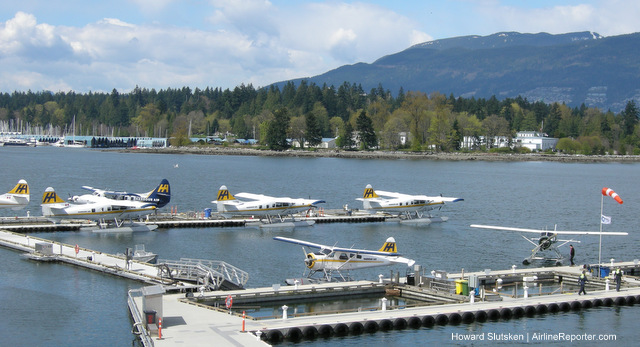
Vancouver Harbour Flight Centre with LOTS of Harbour Air seaplanes.
That’s Stanley Park & Vancouver’s North Shore Mountains in the background.
Harbour Air operates as a daytime-only, visual flight-rules (VFR) airline, which means they don’t fly at night or when the weather is down. The flight time between Victoria Harbour (YWH) and Vancouver Harbour (CXH) is about 35 minutes. Their Vancouver Terminal is part of the new Vancouver Convention Centre, and Harbour Air’s move to the new facility wasn’t without controversy and cost. But it’s a really beautiful terminal. In Victoria, they’re planning to build a new floating terminal in the Inner Harbour to replace the current, old dock. When passengers arrive, Harbour Air provides a shuttle bus to locations in both downtowns. On a nice day, I used to walk from my office in Victoria to the dock, and from the Vancouver dock to my meetings.
The flights were always great. The turbine Otters operate with a single pilot, so the right seat is available (at the pilot’s discretion) for whomever gets there first. Ummm’¦I didn’t always sit there, really! When I did, though, I always watched and learned from the pilot’s technique and enjoyed the view along the route, over the beautiful Gulf Islands and usually right over Vancouver International Airport (YVR).
Harbour Air provides earplugs for passengers — you’re sitting not very far behind a PT6 turbine so it isn’t exactly quiet in the cabin. And there are 2 PT6s on the wings if you’re flying in the Twin Otter, the plane I think is the world’s best floatplane. Pilots can make that plane dance on the water, with twin engines and reverse pitch on the props. Who needs wheels and brakes?
Full fare for Harbour Air’s Victoria-Vancouver flights are CA$189 each way and seniors/students can get discounts. However, I’ve seen fares as low as CA$65 for seat sales, promoted on their Twitter account @HarbourAirLtd.
HELIJET
I have to be honest ’“ I love helicopters (notice a trend here?). I know about the aerodynamics of helicopters and how the controls work and stuff, but really, it’s magic. To be able to lift vertically off the ground, transition to flight, and then, if you want to, just stop in midair ’“ amazing!
In operation since 1986, Helijet is arguably the most successful scheduled helicopter airline in the world. In addition to their scheduled services, Helijet has a busy medivac and charter operation. The Victoria ’“ Vancouver schedule is usually flown by the Sikorsky S-76. The S-76 is a twin-engine helicopter, with both turbines feeding power to the rotors through a central gearbox. Helijet’s S-76s can fly at night, and can fly in Instrument Flight Rules (IFR) conditions. So unless there’s fog at the helipads, the S-76s will usually be flying. During the beautiful West Coast summer, the Bell LongRanger takes over the schedule, with a 45 minute flight time.
Victoria’s heliport is at Odgen Point, a bit of a hike from the Inner Harbour, but Helijet provides a shuttle bus to make it easy to get into town. The Vancouver heliport is right beside the downtown transit hub, and is a short walk from the city core if you don’t want to use the shuttle bus. Both terminals are utilitarian on the outside, but comfortable with all services inside.
All flights arrive and depart over the water. With Transport Canada oversight, Helijet has created instrument approaches to both heliports for use when the weather is bad. I guess the pilots could actually bring the S-76 to a hover at the ’œDecision Height’ just offshore, but that never happened when I was onboard. With the short 30 minute flight time, the crews usually know what kind of weather to expect at the other end before they take off. But sometimes the weather changes quickly and the flight diverts either to Victoria International (YYJ) or to Helijet’s base at Vancouver International (YVR). It’s a bit of an inconvenience, but when that happens Helijet shuttles passengers to the heliports by van. Safety always comes first!
A flight in one of Helijet’s S-76s is pretty smooth. There’s some vibration from the rotor systems, but the helicopter cuts through any turbulence really well. The cabin is…cozy. 3 rows of 4 seats each, with doors on both sides of the ’˜copter. In spite of some soundproofing in the cabin, I think earplugs are pretty well a necessity, and provided. You’ve got 2 turbines screaming about three feet above your head, and the main rotor blades beating the air into submission just a few feet higher.
Fares on Helijet are between about CA$150 for off-peak travel and CA$305 in peak times, each way, depending on the time of year. Their peak time summer fare is CA$199 right now. Helijet does offer daily specials as low as CA$73 on limited seats. The specials are tweeted by their feline mascot, Rotor [@RotorCat], who is the official ’œPest Control Coordinator’ at the Vancouver heliport.
So, which way to fly?
Back then, my office in Victoria was a short walk to Harbour Air’s dock, and the right seat in the Turbine Otter was always calling. But when the weather was down, or when I was travelling from November to April or so, I was often on one of Helijet’s S-76s. Sometimes flights were sold out at popular times so I would switch to the other airline. I think a lot of other corporate passengers did and still do the same.
And when the weather was nice, it was always a beautiful flight on either airline. Sparkling water, San Juan & Gulf Islands, Mount Baker, boats, and sometimes pods of orcas. Love it!
Which way would you go? Fly Helijet or Harbour Air, or take BC Ferries? Leave a comment and tell us.
 |
This story written by… Howard Slutsken, Correspondent. Howard has been an AvGeek since he was a kid, watching TCA Super Connies, Viscounts and early jets at Montreal’s Dorval Airport. He’s a pilot who loves to fly gliders and pretty well anything else with wings. Howard is based in Vancouver, BC.@HowardSlutsken |
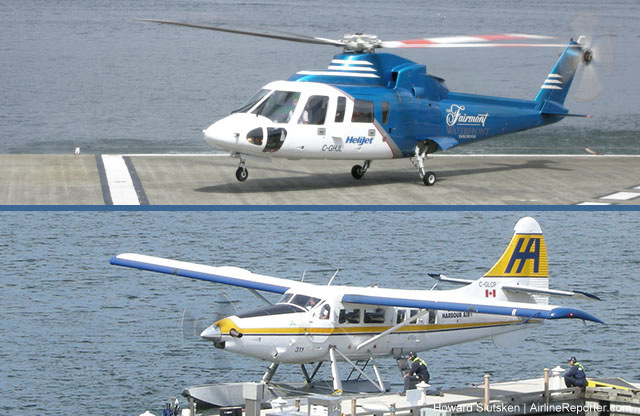
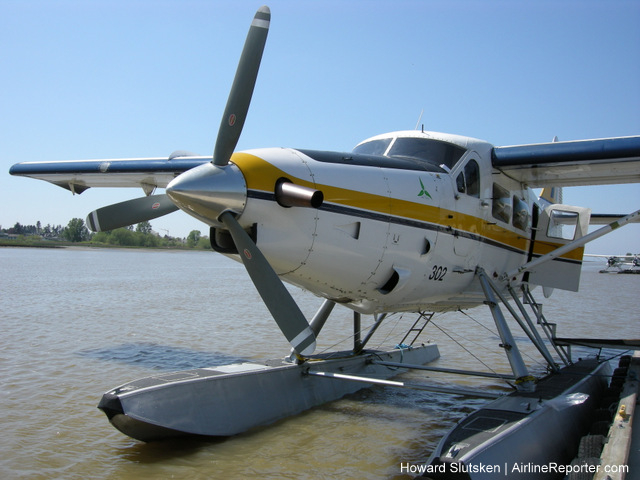
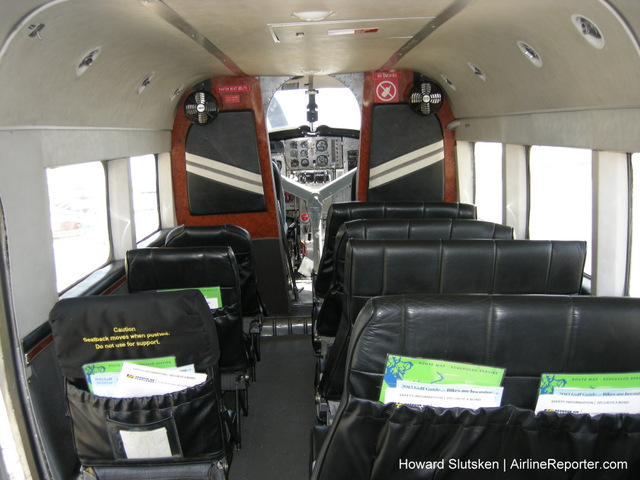
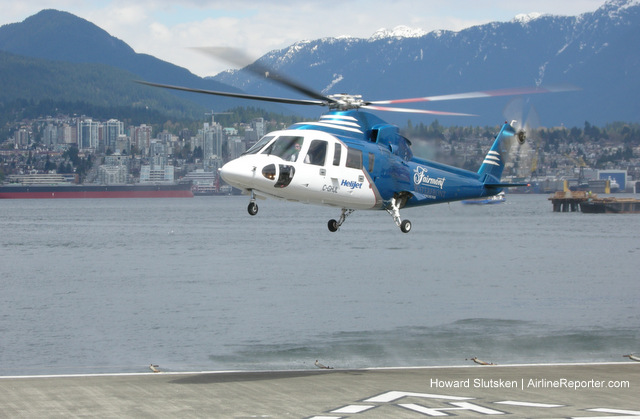
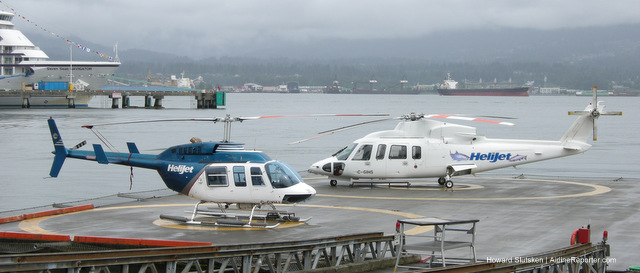
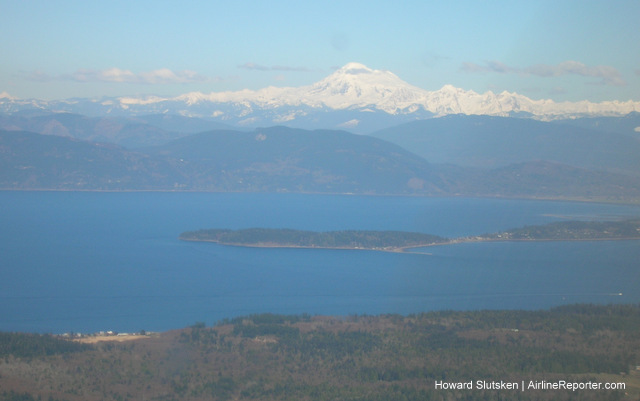
Helicopters are neat, but fixed wing flight is what truly excites me. HA seems to run a good shop, and I enjoyed my flight on West Coast air from Nanaimo Harbour to Vancouver Harbour a few years ago (I had the front seat too!).
Thanks for the profile on these two unique carriers!
Floatplanes for me every time. I did this trip some years ago from Coal Harbour with Harbour Air on the Twin Otter. Brilliant!! On the way back the crew spotted a pod of Orca’s and did a circuit over them so we could all have a look. I couldn’t have asked for more!
Great article.
Yep, Harbour Air, but I may be a little biased…Harbour is my last name!
Am I the only one who for some reason associates Harbour Air with Kenmore Air??
Thanks for the great comments, folks!
Ken, I had an orca sighting during one flight on Helijet. It was a gorgeous day and the flight took the low level routing near East Point. I have to admit that I’ve seen orcas a bunch of times on the ferry, and they were a whole lot closer! If you like the Twin Otter, check out my story on the new Series 400. Click on my name in this story and you’ll find it.
Shane, Kenmore Air is also a floatplane airline, but they’re based in Seattle. They fly to a bunch of places in the US San Juan Islands and Victoria. They also fly the Cessna Caravan on wheels to a number of destinations. The link in the story about the new terminal in Victoria notes that it’ll be shared with Kenmore.
Howard
Thanks for a great comparison to these two local carriers!
Howard, do you happen to know what conditions HeliJet don’t fly in? I know that fog is a showstopper for the float planes. Can the HeliJet fly under high wind conditions like a commercial airliner or is there a point where they’re also grounded?
This helps to describe how much sound decibels the sound proofing material to block or absorb.
With industries and commercial properties cropping up fast, it is becoming difficult to find exclusive areas to
build our homes or offices. Your upstairs neighbors might even be
hard of hearing and listening to infomercials at 3 am isn”t your
idea of a peaceful night”s rest.
when did Hellijet drop the use of airlines in it’s name?
Anyone know which one is better for the environment? Is a float plane or helicopter using less fuel for a similar trip?
Thanks